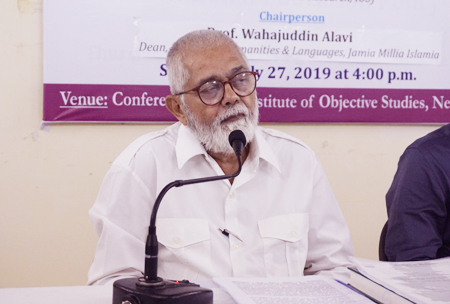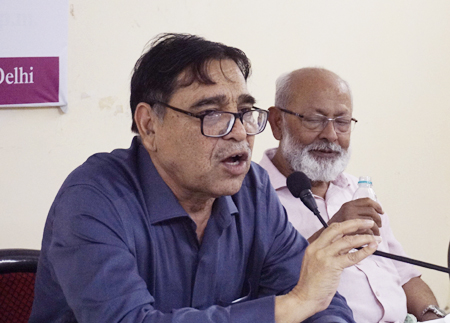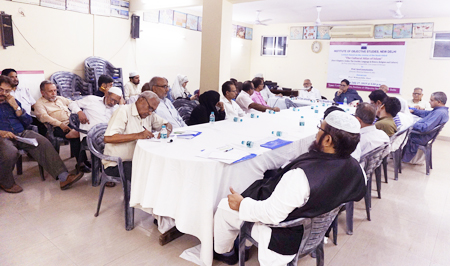IOS Lecture on the book The Cultural Atlas of Islam
July 27, 2019 at Institute Building, 162, Jogabai, Jamia Nagar, New Delhi

A lecture based on the review of the book “The Cultural Atlas of Islam’ (Part-I Chapters: Arabia, the Crucible, Language and History, Religion and Culture) by Prof. Ismail Raji al-Faruqi and Ms Lamya al-Faruqi was organised by the Institute of Objective Studies (IOS) at its conference hall on July 27, 2019. The lecture was delivered by the former professor of history, Jamia Millia Islamia and currently the director, IOS centre for historical research, Prof. Syed Jamaluddin.

In his lecture, Prof. Syed Jamaluddin said that Prof. Faruqi spoke of phenomenology which, was based on philosophy and psychology. As against most Western and Muslim scholars who had treated their study of Islam either territorially or chronologically, in the Cultural Atlas of Islam the subject had been dealt with according to phenomenological methodology, which required that the observer let the phenomena speak for themselves, rather than force them into any predominant idea national framework. Explaining the phenomenogical method, he said that it had its roots in a 20th century philosophical movement based on the work of the philosopher Edmund Husserl.
As a research tool, phenomenology had become a widely accepted method for describing human experience. A phenomenological study attempted to set aside biases and preconceived assumptions about human experience, feeling and response to a particular situation. Al-Faruqi considered the association of Islam with Muslim history to be crucial. According to him, Islamic culture and civilisation were its offspring, nourished and perpetually sustained by it in every realm of human behaviour. Al-Faruqi’s argument was that Islam “is essence and Muslim and Muslim history is the manifestation of this essence.”
Referring to Chapter-I, “Arabia: The Crucible”, he said that it explained the topography and demography of Arabia, internal and external population, movements and Semitic invasions of outside (Egypt, Phoenicia and Islam). The name Arabia was applied in this book to both the Arabian Peninsula and the Fertile Crescent since each was the continuation of the other and was inconceivable without it. Talking about demography of the region, it was said that the people who inhabited the geographic theatre of Arabia belonged to one race of humans, the Caucasian or West Asian, also known as the Semite. Al-Faruqi was critical of western view of Semites. According to him, none of the peoples called Semite had ever perceived themselves as the biological descendants of Shem, son of Noah, except the Christians and Jews of the modern West. He considered it as ethnocentric which was a creation of Romantic Europe. He argued that the peoples of the ancient near east certainly perceived themselves as peoples in terms of the languages they spoke, the religions and cultures they adhered to or the political regime under which they lived, not their biological descendants or race. He said that except for the Hebrews, the perception of race was absent from Arabia. Al-Faruqi wrote that civilisation had blossomed in Mesopotamia earlier than in Egypt. He showed how Mesopotamia helped in lifting Egypt from pre-history to history. He noted that the expansion of Arabia under Islam was most successful and furthest reaching.
Commenting on Chapter-2 which dealt with “Language and History”, Prof. Jamaluddin observed that Al-Faruqi discussed the linguistic integrity or unity of Arabian peninsula. In this regard, the author looked upon the Semites as a linguistic family. Almost all of the Semitic languages were now defunct with Arabic as the only language with real life. In the seventh century C.E., with the approach of Islam, Arabic displaced Aramaic throughout West Asia. Under the influence of Islam, it had influenced the Persian, Turkish, Urdu, Malay, Hausa and Sawahili languages, giving them 40-60 percent of their vocabularies and affecting their grammar, syntax and literatures. It was now the religious language of a billion Muslims across the world.

He said that Al-Faruqi cited genealogical tradition to explain the origin of Arabic. He concludes that the Arabic language in which the Quran was revealed, was the language of all Arabs in the peninsula; that it was acquired by the Makkans and south Arabians in distant times as a consequence of population movement into those areas, and that the desert was the birth place of migrating tribes as well as of their language, Arabic. “The second part, he said, dealt with the people migrating from one part to the other. The author noted that the processes of immigration, settlement and integration were slow. Again, the role of the language immigrants who carried with them their linguistic and cultural ethos to distant and opposite directions had been emphasised in the integration of the Arabian peninsula. Mesopotamian contribution to unity and integrity of Arabia was also highlighted in this chapter, he noted.
Prof. Jamaluddin touched upon Chapter-3, “Religion and Culture”, which opened with a discussion on a question of method to treat the topic of Mesopotamian Religion. The author suggested that Mesopotamian religion might be distilled out of the thousands of texts, literary, historical, mythical as well as legal sources. Talking about the essence of the Mesopotamian religion, Al-Faruqi compared it with the Egyptian and Indian religion. He said that in contrast to both, Mesopotamia maintained a dualistic doctrine in which God was divine, and the creature, creaturely. Mesopotamia consistently maintained their separateness. Another core principle which belonged to the essence of Mesopotamian religion affirmed the human capacity to perceive and understand the divine will, to implement it and bring about the desired goals and objectives. He said that the Mesopotamian thought that humans without an orderly state were like “sheep without shepherd”. The vision of an ideal social order motivated the desert people to migrate to different parts of the world.
Mesopotamia became part of the Persian Empire under Cyrus. Zoroastrianism introduced its ideas in Mesopotamia that penetrated Judaism and through it, Christianity. The Mesopotamian culture suffered little change because Persia had already been influenced by Mesopotamia for two millennia. Al-Faruqi was critical of Hebrew beliefs, like regarding God as their Father, as belonging to them as they belonged exclusively to Him, and their referring to themselves as the sons of God. He made it clear that the Hebrews produced no civilisation in ancient times. They were part of the Semitic whole composed of Arabia and the Fertile Crescent. Al-Faruqi lamented that the Hebrews were incapable of spreading the good they had, namely, the transcendental monotheism of Abraham. The religious situation of the Jews at the time immediately preceding the advent of Jesus called for a prophet to reform it. There was required a movement to break the ethnocentric particularism on Jewish minds and to reaffirm their equality with all humans and restore divine transcendence at the core of the faith.
Prof. Jamaluddin said that the contribution of Judaism and Christianity to Islam was numerous indicated by the co-existence in both of identical religious personalities, events, ideas and principles. But, in the opinion of Al-Faruqi, co-existence was not a contribution. He also rejected the view of western scholars affirming such contribution as “borrowings”. The author continued that Islam was the oldest religion, being the eternal religion of God, of Adam, of Noah and his progeny. It saw itself as the religion of Abraham and his descendants, of Moses, of Jesus and of all the prophets God had sent. Al-Faruqi emphasised that Islam accepted the religious legacy of Mesopotamia as its own, since the Mesopotamian civilisation was the product of Arab migrants from the peninsula as they settled in Mesopotamia and were re-enforced by the continuous flow of humans from the desert into the Fertile Crescent, from the thirtieth to the thirteenth century B.C.E. like the Mesopotamian tradition, the religious tradition of the peninsula came to be influenced by Abraham’s reformative ideas which came into it through Ishmael whom Abraham chose to bring back to the peninsula and settle in Makkah (Paran or Faran) and who became the ancestor of many great peoples.
He said that both Jews and Christians were welcomed by those Arabs who upheld the Mesopotamian-Abrahamic tradition. Together, they consolidated that tradition in peninsular Arabia which came to be known as Hanifiyyah. Its adherents, the Hanif (s), resisted every association of other gods with God, refused to participate in pagan rituals, and maintained a life of ethical purity. The Prophet (PBUH) knew the Hunafa well enough to say: “Islam is identical with Hanifiyyah,” and above him stood the Quran’s authoritative identification of Abraham as Hanif.
Prof. Jamaluddin held that as a young man of fourteen, Prophet Muhammad (PBUH), was involved in the Battle of Fijjar (584 CE), fought between his tribe, Quraysh, and the tribes known as Kinanah Qays–Aylan. This battle received its name, which meant “desecration” because the enemies of the Quraysh broke the taboos commonly agreed on by all Arabs not to fight within the haram or during the holy months. Unlike other battles, this one did not produce heroic poetry, but shook all Arabs into awareness of the futility of these struggles. Voices were raised everywhere to end the bloodshed, which prepared the ground for the call of the Prophet (PBUH) to repudiate tribalism and unite all Arabs under the banner of Islam. He said that the Arabs’ love for poetry led them to hold an annual competition at the Ukaz Fair on the occasion of the annual pilgrimage to the Ka’bah. The best composition was written in gold and hung on the walls of the Ka’bah. Generations of Arabs were delighted in learning and reciting these poems, he concluded.

In his presidential address, Dean, Faculty of Humanities and Languages, Jamia Millia Islamia, Prof. Wahajuddin Alvi, held that all the three chapters of the book formed the subject that was being discussed in the world today. He said that civilisations neither came into existence nor died so often as might be believed. Mesopotamian civilisation was very old and existed even today. He noted that there was science of astronomy, but Islam did not believe in predictions. Islam did not reach us direct. It came to India from Arabia. Arabian civilisation was never puritanical nor was it so even today. He said that there was a difference between religion and civilisation and the concept of Khuda came to India as Allah from Iran, he added.

Earlier, the lecture began with the recitation of a Quranic verse by Hafiz Athar Husain Nadwi. Shah Ajmal Farooq Nadwi introduced the subject and conducted the proceedings. He also proposed a vote of thanks. The lecture was attended by scholars, university teachers, researchers and prominent citizens, including the chairman, IOS, Dr. Mohammad Manzoor Alam, secretary general, IOS, Prof. Z.M. Khan, assistant secretary general, IOS, Prof. Haseena Hashia, Dr. Fazzur Rahman, Dr. Mohammad Sohrab, Syed Ashraf Rizvi, Safi Akhtar, Maulana Abdul Hameed Noumani, Bismil Arifi, Yusra Zainab and Shabbir Ahmad.
|